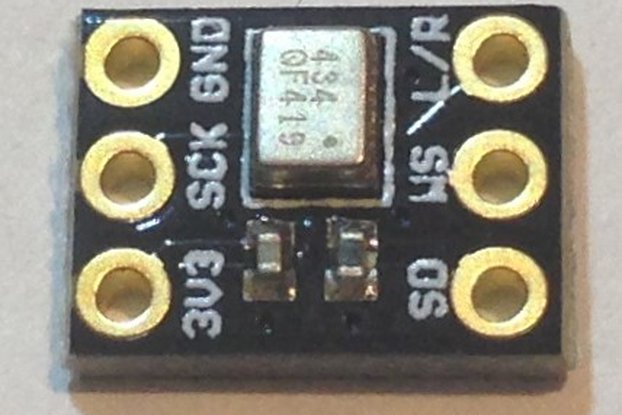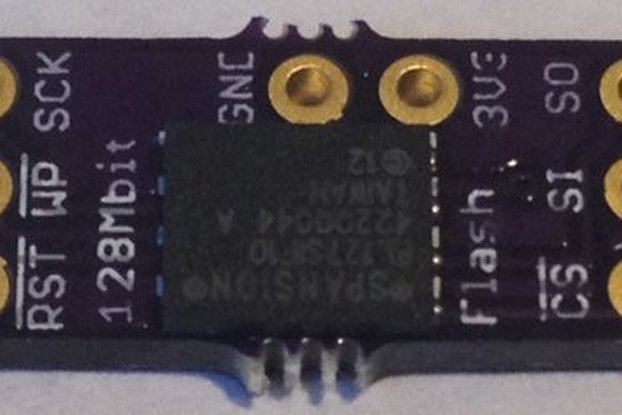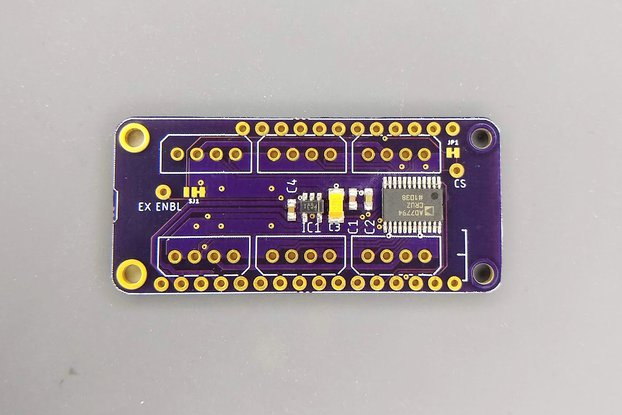Flexible GPIO extension board with fast SPI interface
Designed by Pesky Products in United States of America
This product is no longer available for sale.
The seller may be offering an improved version or it may be hanging out on the beach, enjoying the retired life.
What is it? This is a small (1.0 x 0.6 inch) breakout board for Analog Devices AD5592R "8-Channel, 12-Bit, Configurable ADC/DAC with on-chip Reference" using SPI to interface with your microcontrolle…
Read More…This is a small (1.0 x 0.6 inch) breakout board for Analog Devices AD5592R "8-Channel, 12-Bit, Configurable ADC/DAC with on-chip Reference" using SPI to interface with your microcontroller. The SPI interface means you can gang these breakouts together to read as many analog sensors as your project requires by devoting just one extra MCU GPIO for chip select per AD5592 breakout board.
From the AD5592 data sheet: "The AD5592R-1 has eight I/Ox pins (I/O0 to I/O7) that can be independently configured as digital-to-analog converter (DAC) outputs, analog-to-digital converter (ADC) inputs, digital outputs, or digital inputs. When an I/Ox pin is configured as an analog output, it is driven by a 12-bit DAC. The output range of the DAC is 0 V to VREF (= 2.5 V) or 0 V to 2 × VREF. When an I/Ox pin is configured as an analog input, it is connected to a 12-bit ADC via an analog multiplexer. The input range of the ADC is 0 V to VREF or 0 V to 2 × VREF. The ADC has a total throughput rate of 400 kSPS. The I/Ox pins can also be configured as digital, general-purpose input or output (GPIO) pins. The state of the GPIO pins can be set or read back by accessing the GPIO write data register or the GPIO read configuration register, respectively, via a serial peripheral interface (SPI) write or read operation."
The AD5592R is quite flexible and offers the user eight extra ADCs, or eight extra DACs, or 8 extra digital GPIOs or any combination of eight extra 12-bit GPIO channels. The eight channels are exposed on the board in groups of three 0.1"-spaced plated through holes (PTH), each including the AD5592R signal (IO0 - IO7), VDD, and GND. Connections can be made to the board by soldering wires to the PTHs, or by plugging in jumper wires into machine pin headers soldered into the PTHs, or by using some other appropriate connector.
VDD can range from 2.7 to 5.5 V, so this AD5592R breakout will accommodate both 3V3 and 5V analog sensors. VDDIO can range from 1.62 to 5.5 V and is independent from VDD so this AD5592R breakout allows use of 3V3 MCUs to read and control 5 V analog sensors. However, VDD and VDDIO can be connected using the solder jumper on the back of the board in case both the analog and digital power rails are the same (i.e., both 5 V like with a 5 V sensor and a 5 V Arduino UNO or a 3V3 sensor and a 3V3 MCU like a Dragonfly or Teensy).
This breakout is designed to make use of the internal reference voltage (VREF = 2.5 V) only to set the range of the analog input (ADC) and output (DAC), which can be set to either VREF or 2 x VREF. The VREF pin allowing different, external reference voltages is not exposed to the user in this design.
I needed a way to read a large number of 5 V analog sensors with the additional constraint of maintaining a common timing baseline for all of the data. The easiest solution was to use one MCU and a large number of ADC channels. I chose the AD5592R because of its simplicity, small size, and low cost as well as its versatility. The 12-bit resolution was good enough for the needs of the project. The simplicity and small size allowed many of the AD5592 to be designed into a small, 2-layer controller board that reduced the overall cost of the project.
The individual breakout boards offered here were designed to test the solution and I find them still a very useful tool to quickly interface analog sensors to an MCU or get a few more digital control pins, etc. for my various projects.
The AD5592R breakout board is small and simple to use. The open-source design is readily adaptable to custom form factors. The board is useful as a testing tool and will find uses in many applications, but it also serves as a template for integration into custom designs, especially those where multiple AD5592R might be required.
I am working on an Arduino sketch to make use of the AD5592R but in the meantime, there is a Linux driver available from Analog Devices here.
Order the pcbs from OSH Park and assemble some of your own or order the fully-assembled and tested AD5592R breakout boards here and see how useful eight extra GPIOs can be for your project!
Danville, CA, United States of America
Ships from United States of America.
180 Reviews | 5,478 Orders

$49.95
Free Shipping!

$5.95
Free Shipping!

$35.95
Free Shipping!

$35.95
Free Shipping!

$49.95
Free Shipping!

$29.95
Free Shipping!

$19.95
Free Shipping!

$12.95
Free Shipping!

$21.95
Free Shipping!

$3.00
Free Shipping!

$30.00
Free Shipping!

$30.00
Free Shipping!
By clicking Register, you confirm that you accept our Terms & Conditions
We recognize our top users by making them a Tindarian. Tindarians have access to secret & unreleased features.
We look for the most active & best members of the Tindie community, and invite them to join. There isn't a selection process or form to fill out. The only way to become a Tindarian is by being a nice & active member of the Tindie community!
